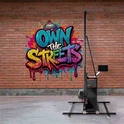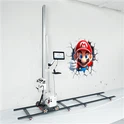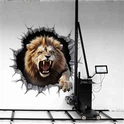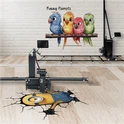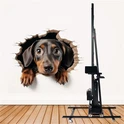From Rolls to Pixels – A New Era of Wall Design
For decades, wallpaper was the easy answer to bare walls. It's colorful, familiar, and often affordable. Yet tastes have changed. Today's clients expect personalized art, low maintenance, and eco‑safe materials.
That shift created room for wall printing - a digital process that prints directly on the wall surface.
With Tanyu uv wall printers, designers reach new levels of freedom: no rolls, no glue, just pure image.
How Each Method Works
Wallpaper relies on pre‑printed paper or vinyl rolls. They're pasted manually using adhesive glues that can contain volatile organic compounds (VOCs). Curing takes hours and the smell can linger for days.
Wall printing, by contrast, uses a vertical UV printer. It sprays UV‑curable ink and instantly hardens it under ultraviolet light. The result is a solid, low‑odor, low VOC film that becomes part of the wall.
Ink vs Glue – Health and Air Quality
Adhesive glues in wallpaper releases VOCs over time. The odor may fade, but tiny traces can remain for months.
Tanyu's UV inksare formaldehyde‑free and comply with EU indoor air standards. Once cured, they emit minimal VOCs and seal instantly.
Result:
- Cleaner air for homes and workspaces.
- No drying time.
- Water‑ and sunlight‑resistant finish.
Size and Seam Limitations
Wallpaper comes in fixed widths - 53 cm or 68.5 cm (≈ 21- 27 in). Every join adds a visible seam. Long walls need many rolls and
precise alignment.
Wall printing removes that constraint. Printable width depends only on the machine track length. Height averages 3 m to 4 m (≈ 9.8–13 ft), enough for most indoor projects.
The only off‑limit zones are edges of 5–10 mm around corners - a needed margin for printhead safety.
Output: A seamless, continuous image from floor to ceiling.

Surface Adaptability
Wallpaper demands a perfectly smooth wall - dry and dust‑free. Any bubble or crack shows immediately.
UV wall printers handle more diverse materials:
Brick • Concrete • Plaster • Wood • Drywall • Glass • Metal.
Proper UV printing coating liquid ensure adhesion and durability.

Durability and Lifetime Costs
Wallpaper fades or peels after 2–4 years in humid or sun‑exposed spaces.
UV ink prints stay bright 5 to 10 years indoors (depending on light and cleaning).
ROI Example:
A 100 m² (≈ 1,076 ft²) office spends 2,500 on wall printing vs. 2,500 on wall printing vs. 1,800 on wallpaper.
Over 5 years it saves about $1,200 in repairs and labor.
ROI ≈ (1,200 ÷ 2,500) × 100 = 48 %.
You spend slightly more initially but replace it half as often.
Visual Depth and Artistic Range
Embossed wallpaper creates texture by heating PVC layers into pre‑set patterns. Depth is limited to about 1 mm.
Wall printing builds its own texture by layering UV ink up to 3 mm thick. Each pass adds shadow and relief. The effect is tactile and customizable.
Design options include:
- Photo murals and branded graphics.
- 3D art murals with brush‑stroke textures.
- Gradient color transitions impossible on standard rolls.
This is not about imitation; it's genuine sculpted ink.
Sustainability and Environmental Impact
Wallpaper produces waste during printing, trimming, and installation. Old rolls and backing papers end up in landfills.
UV wall printing cuts waste to near zero: it prints only what you design and uses no packaging or glue. Curing is energy‑efficient because
it requires no heat drying.
This makes it ideal for green buildings and LEED/ BREEAM projects.
Hybrid Potential for Wallpaper Businesses
For traditional retailers, wall printing means expansion, not replacement.
Wallpaper stores already have customers, design skills, and market trust. Adding a vertical uv wall printer brings service flexibility.
They can offer:
- On‑site custom murals.
- Logo walls for cafés and offices.
- 3D art sections beside classic paper panels.
This model redefines the store as a creative wall studio, blending tradition with technology and shifting profit from product sales to design services.
So… Which Is Better?
If you value heritage, texture, and hand‑crafted detail, wallpaper still has a place.
If you seek custom graphics, faster installation, and eco‑responsibility, wall printing is the clear winner.
The smartest designers use both: wallpaper for intimate textured rooms, wall printing for feature walls and brand spaces.
In the end, the question isn't which survives but which combination tells your story best.
Final Thought – Walls as Canvas, Not Backdrop
Interior design is moving from decoration to expression. UV wall printing turns walls into media for art and identity, not just color.
Tanyu's advances in 3D ink layering, color management, and low VOC chemistry are making it a global standard.
Wallpaper defined the 20th century. Wall printing is defining the 21st.
FAQs
1. Is UV wall printing safe indoors?
Yes. Cured inks are low VOC and low odor. SDS is available on request.
2. How long does wall print last?
Eight to ten years indoors with proper uv ink.
3. Can it print on dark walls?
Yes. Use a white uv ink for bright color.
4. Can I change the design later?
Yes. Lightly sand, reprime, and reprint new artwork.
5. Outdoor use?
Yes with UV‑protect finish; expect faster color aging from sun exposure.
6. Corners and edges?
Avoid raised textures over 3 mm and tight radii under 5 cm for printhead clearance.

